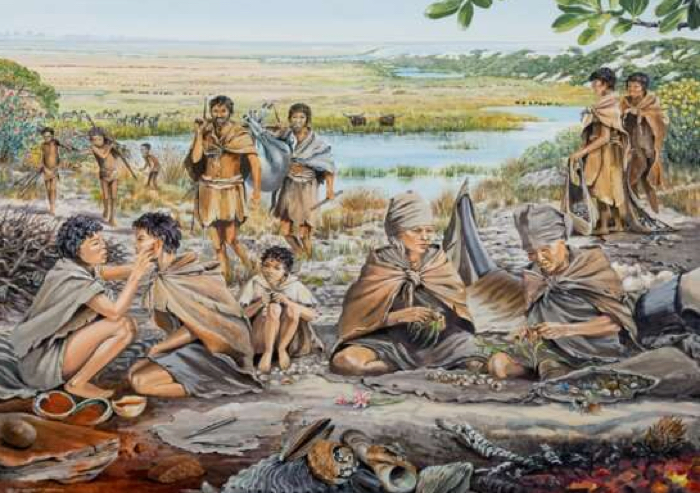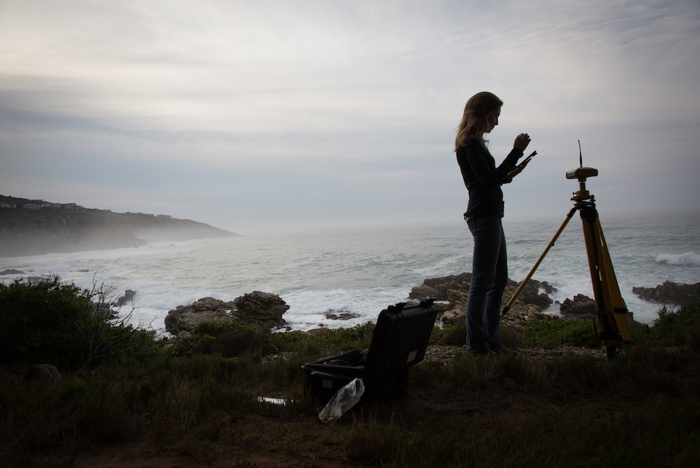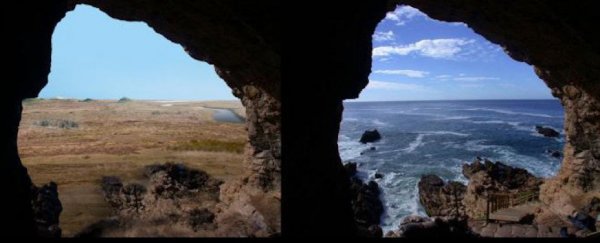New research details the hidden ecosystem that once acted as an Eden-like sanctuary for animal life, including early humans, at the southern tip of South Africa.
The Palaeo-Agulhas Plain (PAP), now submerged by ocean waters off the South African coast, could have provided a rich habitat for all kinds of animals during glacial periods, when coastal waters receded, exposing a shallow continental shelf at the southern tip of the African continent.
These days, researchers study the landscape – and the ancient evidence it reveals about early humans – through cave sites such as those at Pinnacle Point, near Mossel Bay.
Today, those crags are coastal caves, but in times long past the same sites would have looked out over vast plains inundated with rivers.
"During glacial cycles, the coastal shelf was exposed," explains anthropologist Jamie Hodgkins from the University of Colorado Denver.
"There would have been a huge amount of land in front of the cave sites. We thought it was likely that humans and carnivores were hunting animals as they migrated east and west over the exposed [shelf]."
 Artist rendering of the Palaeo-Agulhas Plain during the Pleistocene. (CU Denver)
Artist rendering of the Palaeo-Agulhas Plain during the Pleistocene. (CU Denver)
To test that hypothesis, Hodgkins and her team analysed the teeth of ancient herbivorous antelopes who lived at the site approximately 150,000 years ago, looking for signs of carbon and oxygen isotopes preserved in the tooth enamel, which can be used as an indicator of the travelling patterns of the animals.
Scientists already knew that seasonal rainfall influences the types of plants that grow in the eastern and western zones of the region; the presence of these plants in the animals' diet could be traced through analysing molecular isotopes such as carbon-13 and oxygen-18, the latter of which shows up differently in summer and winter rainfall.
Hypothetically, then, varying isotope ratios found in the animals' tooth enamel (via the isotopic signature called δ13C) could indicate the migratory expanse of the antelopes, moving between regions as the seasons changed. But that's not what the researchers found.
Comparing the teeth from 39 specimens of ungulates (hoofed animals), including hartebeest, wildebeest, and springbok, the researchers found that the isotope signature, for the most part, didn't vary between migratory animals and non-migratory animals – such as the common reedbuck, which served in the study as a control group.
"Overall, the δ13C results do not support an ecosystem model in which most herbivores were undergoing long distance point-to-point migrations that would be consistent with an east and west migration system along the PAP," the researchers write in their paper.
That finding parallels a similar discovery made in a previous study, leading Hodgkins and team to conclude that the conditions in the exposed, coastal PAP region could have been so flourishing, that even migratory animals opted to stay put.
 Study first author Jamie Hodgkins in South Africa. (CU Denver)
Study first author Jamie Hodgkins in South Africa. (CU Denver)
"They weren't struggling at Pinnacle Point," Hodgkins says. "We now know that powerful river systems supplied the expanded coast, thus animals didn't have to be migratory. It was a great location, resource-wise."
This coastal shelter wasn't just bountiful for creatures on hoofs, either. The same hospitable conditions would have likely attracted a diverse array of animal life, making the terrain a rich hunting ground for early humans in the Pleistocene, regardless of how glacial cycles may have determined the shoreline over the eons.
"During interglacials when the coast moved closer to the caves humans had shellfish and other marine resources, and when the coast expanded in glacial times hunters had access to a rich, terrestrial environment," Hodgkins says.
"Hunters wouldn't need to be as mobile with all of these herbivores wandering around."
Related research from some of the same team has previously found evidence to suggest humans thrived in this area even during the eruption of the Mount Toba supervolcano about 74,000 years ago.
Such an achievement might not have been possible without the generous resources afforded by this coastal haven, enabling humans to overcome even the terrible hardships of a volcanic winter.
While there's still a lot we don't fully understand about the Palaeo-Agulhas Plain and the ancient conditions that prevailed in this long-gone landscape, we're learning more than ever at the moment.
Hodgkins' study is part of a new collection that brings together 22 research papers on this ancient Eden, helping us comprehend just how important this vast prehistoric ecosystem was in sheltering and enabling life during the Pleistocene.
"The Palaeo-Agulhas Plain, when exposed, was a 'Serengeti of the South' positioned next to some of the richest coastlines in the world," says lead researcher on the project, archaeologist Curtis Marean from Arizona State University.
"This unique confluence of food from the land and sea cultivated the complex cultures revealed by the archaeology and provided safe harbour for humans during the glacial cycles that revealed that plain and made much of the rest of the world unwelcoming to human life."
The findings are reported in Quaternary Science Reviews.
